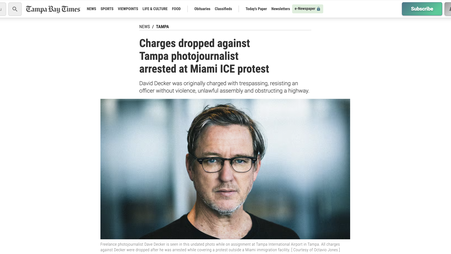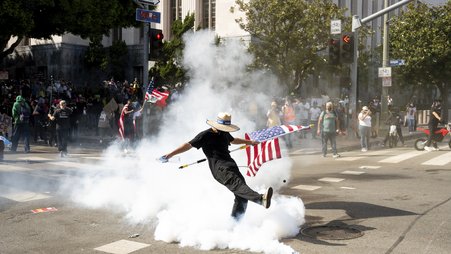In June, a man entered the newsroom of the Capital Gazette in Annapolis, Maryland, and shot and killed four journalists and a media worker. Their names were Rob Hiaasen, Gerald Fischman, John McNamara, Wendi Winters, and Rebecca Smith. It emerged later that the shooter had been harassing and threatening the Gazette for years.
Earlier this year, a independent music journalist Zachary Stoner was also shot and killed, bringing the total number of members of the press killed in 2018 in the United States to five. (The US Press Freedom Tracker has not established the motive in the murder of Stoner, but there are some indications that it could be related to his work.)
Before 2018, the last time a journalist was killed in direct reprisal for their work in the United States was in 2007, with the murder of Oakland-based reporter Chauncey Bailey. In 2017, when the US Press Freedom Tracker—a reporting website and database attempting to systematically document press freedom violations in the United States—launched, we did not anticipate the need to track the number of murdered journalists, or to add a “killed” tag to the Tracker’s incident database.
The journalistic landscape in the United States is volatile, and 2018 has been a harrowing year for press freedom. The Tracker has documented more than 100 press freedom incidents since January, from murders and physical attacks to stops at the border and legal orders.
2018 saw an aggressive uptick in the number of leak investigations by the Trump administration compared to 2017. Five government employees or contractors have been charged with allegedly sharing information with the press—Reality Winner, Terry Albury, Joshua Schulte, James Wolfe, and Natalie Mayflower Sours Edwards—and there could be others that have not been publicly reported.
Fewer journalists were arrested in 2018 than 2017, which was marked with high levels of protests, at which numerous members of the press were arrested. Though the number is still disturbing: at least 11 journalists were arrested while doing their jobs this year. In 2018, journalists were also arrested at protests, but others were arrested while documenting police interactions and courtroom proceedings.
Leak cases
Cases counted in 2017: 1
Cases in 2018: 4
Since 2008, the United States government has aggressively prosecuted journalistic sources. In eight years, the Obama Justice Department brought charges against at least eight people accused of leaking to journalists—Thomas Drake, Shamai Leibowitz, Stephen Kim, Chelsea Manning, Donald Sachtleben, Jeffrey Sterling, John Kiriakou, and Edward Snowden.
At the end of 2017, the Trump Justice Department prosecuted one government contractor in connection with a leak case—Reality Winner. But by the end of 2018, the Tracker has documented another four cases—a significant uptick bringing the total number of prosecutions under Trump up to five.
Terry Albury became the first person to be charged under the Espionage Act in 2018. In April, he pled guilty to disclosing confidential government information, and was sentenced in October to four years in prison. While the news organization in question was not named in the charges against Albury, reporting has identified it as The Intercept, and he is assumed to have shared information about targeted FBI surveillance of minorities and monitoring of journalists.

Terry Albury
The most recent known leak case is that of Treasury official Natalie Mayflour Sours Edwards— who was arrested and charged in October, and stands accused of giving details about suspicious banking transactions to a reporter at BuzzFeed News. The Justice Department has indicated they are investigating dozens more.
Legal orders and subpoenas
Cases counted in 2017: 6
Cases in 2018: 21
The Tracker counts legal orders that are made by state and federal government agencies against journalists, such as subpoenas by prosecutors for journalists to produce their reporting materials or testify in court. This could also include legal orders by private entities on the behalf of public officials—such as an October subpoena by a private attorney for a Chicago police officer for Jamie Kalven, an independent journalist to testify in a trial.
Kalven fought the subpoena—arguing that reporter’s privilege protects him from testifying about his reporting—and won. It wasn’t the first time—Kalven was also subpoenaed to testify and reveal his confidential sources at the end of 2017 in a different case.
The Department of Homeland Security also subpoenaed the editor of an immigration law journal in an attempt to identify the source of a leaked ICE memo, which the editor of the journal had published.
The Tracker has documented a total of 27 subpoena or legal order cases—with 21 of those occurring in 2018. It’s likely that many subpoenas are not reported, and many legal orders for journalists’ records are conducted with high levels of secrecy. Therefore, the number of legal order and subpoena cases counted by the Tracker are likely to be a severe undercount, making a straight comparison of the data between years sometimes difficult.
2018 also saw the first publicly known seizure by the Trump administration of a journalist’s communications records, when the Department of Justice seized years of New York Times reporter Ali Watkins’ phone and email records as part of an investigation into her confidential sources. She was notified of this seizure after the fact, so she had no way to challenge the seizure in court.
Physical attacks
Cases in 2017: 46
Cases in 2018: 35
Across the country, journalists were attacked and interfered with by police and protesters in the course of their reporting. A freelance journalist was ‘decked in the face’ by a police officer in August, and a police officer body-slammed and shoved other reporters covering the same rally. On other occasions, journalists were pushed to the ground and shot with “less-lethal” rounds by police.
And reporters were also attacked by far-right protesters covering rallies in 2018—such as Portland Mercury reporter Kelly Kenoyer, who was shoved in July by a right wing demonstrator, and independent journalist Jon Ziegler, who was struck by white nationalists with a shield while reporting in January.
It’s a physical attack when a journalist faces violence, injury, equipment damage, or aggressive interference as the result of a targeted act by a public or private individual. We’ve documented 35 such incidents this year.
When explosive devices were sent to CNN headquarters in New York City in October, this also comprised a physical attack. The entire bureau was quickly evacuated and the NYPD bomb squad was dispatched, and CNN employees were permitted to return once the building was cleared.
Another suspicious package addressed to CNN was found later at a post office in Georgia, near CNN’s global headquarters.

When a pipe bomb forced the evacuation of CNN's New York bureau, anchors Poppy Harlow and Jim Sciutto used cell phones to report on the situation from a street corner outside CNN's offices.
Arrests
Cases in 2017: 33
Cases in 2018: 11
Journalists were arrested doing their jobs twelve times in 2018, compared to 34 in 2017. While the 2018 numbers are lower than the year before, the circumstances around the bulk of arrests are strikingly similar.
In both years, journalists were arrested at protests—specifically, fascist and anti-fascist demonstrations, and in several cases, protests in opposition to pipeline constructions. In 2017, there were two events in which large journalists were arrested—protests on Trump’s Inauguration Day in January, and protests against the Dakota Access Pipeline. There were comparatively fewer arrests in 2018. Photojournalist Michael Nigro was arrested while documenting an act of civil disobedience in Missouri, and Karen Savage, a freelance reporter, who was arrested multiple times in the course of covering a pipeline resistance protest in Louisiana’s Atchafalaya River Basin.
In one case, Savage said that after arresting her, sheriff’s deputies put her in the back of a police car and drove around through sugar cane fields for around an hour. “It was a very clear intimidation tactic to stop me from covering the story,” Savage said.
“I will go back,” she added. “I’m not going to let them intimidate me. It’s our job to hold these officials accountable.”
While covering a protest in Tennessee, Manuel Duran was also arrested this April. All charges against him were quickly dropped, but he was transferred to the custody of Immigration and Customs Enforcement (ICE), and has remained in ICE detention since the spring. “I was doing my work and nothing more, like any other journalist does,” he said.
And at least two journalists were arrested while taking photographs of police. Susan Greene, after photographing a police interaction in Denver, and Edgar Mendez, for “trespassing” onto police property to take pictures of squad cars for a story.
“I wondered afterwards if what happened to me was because of my brown skin, or because I was a reporter writing about the MPD,” Mendez wrote in a first-person account of the incident for the Neighborhood News Service. “You have to remember that my arrest occurred at a time when President Trump had attacked people of Hispanic descent, repeatedly declared that all the news he didn’t agree with was “fake news,” and begun to call the press the “enemy of the people,” a sentiment he continues to espouse.”
We have attempted to systematically count press freedom violations in the United States since January 2017, the month that Trump entered into office. Much of the rhetoric about the press freedom climate in the United States has focused on President Trump.
We have documented numerous threats and chilling statements by Trump, and other administration officials like ex-Attorney General Jeff Sessions, that pose serious threats to journalism in the United States.
The Trump administration has charged at least five alleged sources of journalists with crimes in less than two years in office—a pace that would shatter the Obama administration’s record on leak prosecutions. Trump has threatened his critics, seized a reporter’s communications in pursuit of her source, and blamed journalists for “creating violence.” His Department of Justice has secretly charged WikiLeaks founder Julian Assange, and if the charges in question relate to Assange’s publishing activities, the press freedom implications would be profoundly devastating. And in November, Trump revoked the press credentials of a reporter that persistently asked him a follow-up question.
But journalists faced diverse threats in the United States while reporting the news in 2018, and many of them have nothing to do with Trump. The journalistic landscape has continued to shift since we began counting incidents at the US Press Freedom Tracker, and we will continue to document threats to free expression as they evolve in coming years.
Note: The categories and cases above do not represent all of the types of incidents that the US Press Freedom Tracker documents; the Tracker catalogs incidents in more than a dozen categories, and the full database is available here. The Tracker also maintains an API endpoint and a link to easily download our data.
This article has been updated to reflect the correct number of attacks in 2017.





